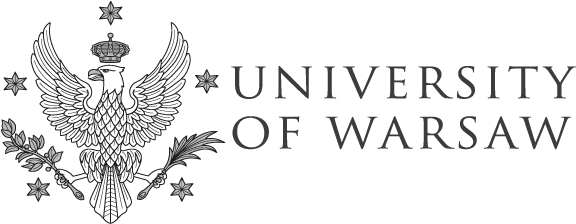
Faculty of Physics



- University of Warsaw
- Institute of Physical Chemistry Polish Academy of Sciences
- Silesian University of Technology
- Wrocław University of Science and Technology
- Institute of Bioorganic Chemistry PAN Poznan Supercomputing and Networking Center
- Maria Curie-Sklodowska University
- Nicolaus Copernicus University

Consortium Member
University of Warsaw, the Project leader, is one of the biggest and best higher education institutions in Poland. It is one of Poland’s biggest employers with more than 7 thousand employees, including almost 4 thousand academic teachers, it has nearly 50 thousand students and more than 3 thousand postgraduate students. The University of Warsaw is engaged in more than 1500 research projects funded from national and international grant programmes, including the most prestigious ERC grants.
research groups
The NLPQT project will be carried out by the following research groups belonging to three departments of the Faculty of Physics: Department of Optics (ZO), Department of Information Optics (ZOI) and Department of Solid State Physics (ZFCSt):
-
Ultrafast Phenomena Laboratory (UPL) more >>
-
Quantum Photonics Laboratory (QPL) more >>
-
Quantum Optics Laboratory (QOL) more >>
-
Ultracold Quantum Gases Laboratory (QGL) more >>
-
Laboratory of Ultrafast MagnetoSpectroscopy (LUMS) more >>
-
The Laboratory of Photonic and Plasmonic Nanostructures (LPPN) more >>
people involved

Consortium Member
The IPC in Warsaw is one of the leading Polish research institutions dealing with widely understood chemistry. In the ranking of scientific institutions run by the Ministry of Science and Higher Education, IPC is listed at the top (category: large scientific units).
research groups
-
Laser Center IPC PAS more >>
people involved
Consortium Member
Silesian University of Technology is the oldest technological university in Upper Silesia and one of the biggest in the country. It was established in 1945 to provide scientific and educational support for the most industrialised district of Poland and, at the same time, one of the most industrialised areas in Europe – Upper Silesia. The mission of Silesian University of Technology is to conduct innovative research and development works, educate highly qualified staff for the society and economy based on knowledge, as well as exerting active influence on development of the region and of local communities. Silesian University of Technology was the only higher education institution in Silesia to be included in the prestigious group of 10 Polish universities – laureates of the contest “Excellence Initiative – Research University” of the Ministry of Science and Higher Education.
research groups
-
Department of Optoelectronics (DO) more >>
people involved
Consortium Member
Wrocław University of Science and Technology (WUST) was established in 1945, mainly thanks to commitment of academic employees of Lvov University of Technology and John Casimir University in Lvov, which no longer exist. Today, the University continues the tradition of these renowned Polish educational institutions, developing in strict cooperation with the leading enterprises of Lower Silesia. It is one of the biggest and best technological universities in the country, occupying top places in national rankings on a regular basis.
The mission of the University is to maintain and develop competences related to the culture of experimentation. These very competences have created our modern civilisation; they are a prerequisite for its existence and the main driving forces behind its development. Nowadays, as experiments are being replaced with procedures and appearances seem to count more than facts, this mission is of fundamental significance.
research groups
people involved
Consortium Member
The Poznań Supercomputing and Networking Centre (PSNC), affiliated at the Institute of Bioorganic Chemistry of the Polish Academy of Sciences, is an ICT research and development institution, recognised in Europe, and a significant hub in the European scientific IT infrastructure. The staff of the PSNC, consisting of more than 300 employees, has many years of experience in such fields as design, optimisation and implementation of digital laboratories, research infrastructures and network services of the newest generation, user training, infrastructure and security management, development of systems and platforms for large-scale data processing. The PSNC is a High-Performance Computing Center (HPCC) and an operator of the national scientific network PIONIER, which connects 21 Metropolitan Area Networks (MANs) and 5 HPC centres. Moreover, the PSNC is a national hub of the European scientific network infrastructures: GÉANT, PRACE and EUDAT.
research groups
-
Network Technology Division more >>
people involved
Consortium Member
Maria Curie-Skłodowska University (UMCS) in Lublin is the biggest university in eastern Poland. In the Universities Ranking of “Perspektywy”, it has occupied a high position among Polish universities in the category “employer preferences”, and in the Lubelskie province, it has been on the top for years. The University is also one of the top higher education institutions in Poland with regard to the total number of foreign students. At present, it has 1900 foreign students from almost 50 countries. UMCS has initiated the Research in Lublin Programme, and in cooperation with the Municipal Office of Lublin has engaged in the initiative to acquire and employ renowned scientists from abroad.
research groups
-
Laboratory of Optical Fiber Technology more >>
people involved
Consortium Member
Nicolaus Copernicus University (NCU) in Toruń was established in 1945 and is now the biggest university in Northern Poland, both in terms of its scientific potential and the number of graduates. It is also among the prestigious group of 10 universities in the country, which have acquired the research university status.
The University has 16 faculties (including three faculties of medicine at the Collegium Medicum of NCU in Bydgoszcz), as well as the Interdisciplinary Centre for Modern Technologies (ICMT). In total, the faculties offer more than a hundred program subject areas in humanities, social sciences, mathematics, life sciences, art and medicine, which have attracted more than 20 thousand students. The two campuses in Toruń and Bydgoszcz employ 4348 people, more than a half of them being academic teachers. Until now, around 200 thousand graduates have finished the University.
 0000-0002-1065-6770
0000-0002-1065-6770 